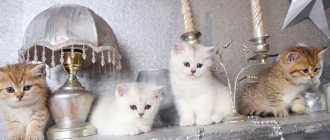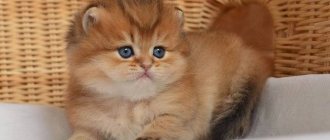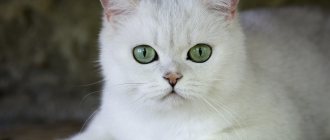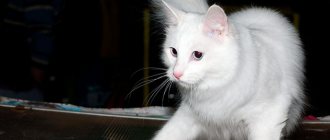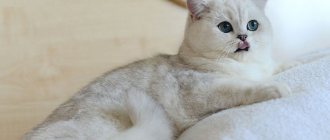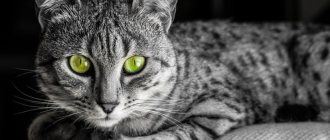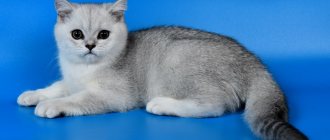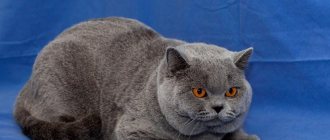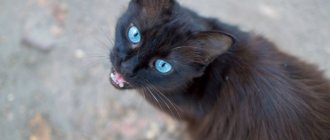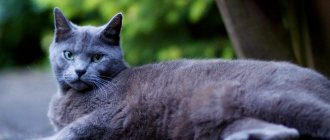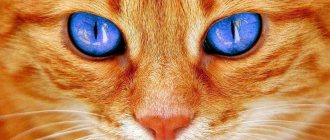- Wild animals
- >>
- Mammals
The British Golden Chinchilla is the name for the color of British cats, or simply a subspecies of the British. The breed itself is distinguished by its amazing kindness and complaisance. It is this color that arouses the greatest interest among breeders of purebred cats, as it is very rare. The homeland of this incredible beauty is considered to be Great Britain, which is where the name British cat comes from. She belongs to the young breeds. A distinctive feature is a very beautiful, fluffy and soft coat.
Story
The history of Chinchillas begins in 1882, when, as a result of crossing British and Persian cats, offspring with an unusual coat color appeared. The owners were delighted and without hesitation decided to breed a new species with a color reminiscent of chinchillas. In 1889, a kitten was born who was given the nickname Silver Lambkin. He became the founder of the variety.
In addition to the silver color, the breeders wanted to fix the green color of the iris. For a long time they strived for this, diluting the blood of Chinchillas with other species. It is believed that not only Persians, but also Orientals, Burmese and other cats participated in the breeding of the breed.
Golden cat
Unfortunately, such mixing gave a negative result. The green color of the eyes was not fixed, and the kittens lost that very unique color of the Chinchilla.
Therefore, felinologists stopped experimenting, continuing only with intrabreed crossing. From time to time they added the blood of Persian cats, but no more.
In the end, the breeders took silver chinchillas as a basis and continued working on colors. They managed to bring out several shades at once: shaded gold and silver. Additionally, another variety of the breed arose - longhaired.
Princess Victoria liked unusual pets. Having settled them in her palace, she encouraged cat lovers to engage in a new subspecies. This is how breeding arose not only in Great Britain, but also in other European countries.
Characteristics and color features
Regardless of the breed, chinchilla cats should have hair with a smooth color transition from soft pink to dark at the tips. The undercoat can be of different shades: from light peach to red. There should be no dull or grayish areas on the body.
The color is considered chinchilla if the dark tip occupies 1/8 of the length of the hair. If 1/3 is painted, the color is called shaded, if 1/2 is called golden tabby.
In chinchillas, the pigmentation of the iris is usually green or bluish-green. There is a dark brown or black edging on the eyelids, lips and nose. The lobe is colored pink, the paw pads are black or brown.
Information about the breed and color of the cat is indicated in the pedigree. Special designations are used for this.
Breed:
- BRI - British;
- PER – Persian;
- SFL – Scots Fold Shorthair;
- SFS – long-haired Scots Fold;
- SCS – Scots with erect ears, shorthair;
- SCL – long-haired, erect-eared Scotsman.
Color:
- y – golden;
- a – blue;
- b – chocolate;
- c – lilac;
- n – black;
- o– cinnamon;
- q – faun.
Picture code:
- 11 – shaded;
- 12 – chinchilla;
- 21 – linx (tabby pattern on the face and paws);
- 22 – marble;
- 23 – brindle;
- 24 – spotted;
- 25 – ticked (each hair has more than two dark zones);
- 33 – point (reminiscent of the Siamese color).
At the end they put numbers indicating eye color:
- 64 – green;
- 61 – blue;
- 62 – yellow.
For example, a Scottish fold short-haired chinchilla of golden color with black tips of hairs and green eyes would be written as follows: SFLny 12 64.
Registration
The British breed was first registered in 1980 by the CFA or Cat Fanciers' Association. Later, the British were recognized by a number of other international felinological organizations:
- WCF - World Cat Federation;
- FIFe - International Cat Federation;
- TICA - International Cat Association;
- IFA - International Felinological Association (Russia and CIS countries).
When trying to recognize Chinchillas as an independent line, breeders encountered difficulties. Their differences from British cats were only in color and coat, which is why not all organizations rushed to register the new breed. Officially, British Chinchillas are an intra-breed variety and felinologists, when registering nurseries, indicate the breed - British Shorthair.
Where and how much to buy a British breed kitten
- In Moscow, British shorthair kittens can be bought at the SunRay nursery. On the nursery website https://www.sunny-cat.ru/ you can see photos of available kittens, book a kitten and find out any other information.
- In Minsk, British kittens are offered by the Krembel nursery creambel.com
- In Kyiv you can buy a British kitten in the cattery “Devinore*UA” www.devinor.com.ua
- Complete list of British Shorthair catteries (in Ukraine and Russia).
The price of British Shorthair kittens may depend on the class of the pet, coat color, prestige of the nursery, and city. You can buy a British kitten “hands-on” for 1,000 rubles, but in a nursery it will be more expensive – from 2,500 to 60,000 rubles. Please note that you can be sure that your pet is purebred only by purchasing it from a certified nursery.
Video
https://youtube.com/watch?v=3Sy9Mkkh0o0
Description of the breed
Chinchillas are medium to large sized cats. They have a strong build and good muscularity. Their distinctive feature is not too long hair and chinchilla color in different variations.
Below is a general overview of the breed’s exterior, as it may differ in independent felinological organizations.
Very beautiful cat with the right head
Life expectancy and weight
The breed is a long-lived breed; with good care, its representatives live 10 years or more. The average weight for both sexes is 3.5-5 kg, individuals up to 7 kg are allowed. Obesity is completely excluded, even in its weakest manifestations.
Head
The head should be round, wide and massive. The transition of the muzzle to the forehead is clear and clearly visible in profile. The skull is strong. All contours are rounded, the forehead is convex, flat is not allowed. The cheeks are full and also round in shape. The cheekbones are wide and visually add roundness to the head.
The nose is straight, short and wide. Medium length allowed. The chin is well developed and strong. The ears are medium in size and set wide apart. The position of the ears should not interfere with the rounded features of the head as a whole. Large at the base, noticeably tapering towards the tips. Rounded. The eyes are large, round and wide. Set wide apart. The iris of the eyes matches the color. A rich color is highly desirable.
Body, tail and limbs
Medium and large bodies are allowed. The body is well muscled and strong. The back is only straight. The chest area is deep and wide. Shoulders are broad. The body is stocky, not too short and not overly stretched. The tail is thick at the base, gradually tapering towards the tip. Its size is 2/3 of the body length. Most often the tail size is described as "medium length", but FIFe characterizes it as "short".
What is a mat cutter for cats and how to use it
Coat and colors
The coat is short, unlike the Nibelung or Ragamuffin, and is soft and plush. It is noticeably longer than most shorthaired cats, but not excessively long (closer to medium). The texture is soft, pleasant to the touch, similar to LaPerm wool, but does not frizz. Does not lie tightly to the body, has abundant undercoat. Wool that is too soft or coarse is not allowed.
The unique color of Chinchillas depends on the melanin inhibitor gene I. It prevents the development of melanin, which is why only the tips of the outer coat are stained, while the base and undercoat itself remain pure white. The “pattern” on a cat’s body almost completely disappears as it grows older.
This is interesting! All kittens are born with tabby (tabby) color - striped or motley. Closer to 3 months it becomes shaded.
Chinchilla color is divided into 2 varieties:
- Tipped (tipping) - partial dyeing of wool, where only the tips receive the main color, and the base remains unchanged white. Dyeing should be no more than 1/8 of the entire length of the hair.
- Shaded (shading) is the same partial coloring of the fur, but its coloring is already 1/3 of the length of the hair.
Silver cat
Silver chinchilla
“Silver” is characterized by the intensity of the pure white undercoat and the same base of the guard coat. Partial staining is distributed evenly throughout the body, due to which the silver tipping color appears.
The ears, belly and chin must be white. The contours of the eyes, nose and lips are black, the nose itself is pale red. Paw pads may be black or brown. The iris of the eyes is green. “Remnants” of tabby on any part of the body are considered defects.
Color silver shading
Silver shading
The shaded color is achieved by more intense black tipping on a white base. It is especially noticeable on the back and smoothly moves to the sides. A lighter shade is noted on the head and limbs. There is always tipped hair on the tail and head.
The white color remains on the lower part of the head, neck, chest and abdomen. The feet are shaded down to the hocks. The color of the paws and head must match. This color is also characterized by black edging of the eyes, nose and lips. The iris of the eyes is green, but blue-green shades are also possible. The color of the paw pads can be chocolate (brown) or black. Brown tabby markings are highly undesirable.
Golden chinchilla color
Golden chinchilla
This color includes an undercoat ranging from apricot to gold. The entire lower part (from the chin to the belly) is a light apricot shade. The contours of the eyes, nose and mouth can be either black or brown.
To achieve a golden color, the cat's body must have brown tipping. The tipped color of the golden chinchilla is much more pronounced than that of silver individuals. The eye color is green, blue or blue-green. The tip of the tail is the area with the most intense tipping on a cat's body.
White color
There is no such thing as a white British chinchilla. Light, silver representatives of the breed are most often mistaken for white. There is no need to look closely; there is a dark awn on top of the white base. This combination causes the silver color.
Redhead
And this option is also not inherent in this breed. This is one of the varieties of golden chinchilla color. In this case, a gray color goes on top of the red base. Quite an interesting combination that makes a rather favorable impression.
And here you will find the schedule of WCF cat shows for 2021.
Flaws
Faults are those defects and anomalies due to which the show animal is penalized in the ring or removed from it altogether. The following deviations are considered to be the faults of British Chinchillas:
- malocclusion;
- abnormal skeletal development (deformation);
- any deviations in jaw development (underbite, weak chin);
- kinks in the tail (vertebral anomalies);
- strabismus (or strabismus);
- too soft or rough coat structure;
- adjacent coat;
- the presence of a pronounced tabby of brown shades on the body of an adult;
- any other deviations from the approved coat conformation.
Description of the Golden British Chinchilla
The basic characteristics of chinchilla cats correspond to the standards of the British Shorthair cat. The difference between these animals is the length and thickness of the fur; representatives of the first breed.
Appearance
British chinchillas are distinguished by a large, wide chest, strong hips and a straight back. In general, their physique is squat, their muscles are well developed. The weight of cats reaches 5-8 kg, cats 3-4 kg.
The breed standard requires compliance with the following appearance features:
- A rounded head with a wide forehead smoothly transitions into a rounded muzzle with round cheeks.
- The nose is straight, short, with a pinkish nose.
- Small ears, rounded at the ends, set wide apart.
- The neck is muscular and short.
- The round eyes are set shallowly. The ideal eye color for chinchillas is emerald, but yellow and blue shades are acceptable.
- The paws are proportional, muscular, but rather short, and therefore give the impression of being stocky.
- The tail is thick and not too long and ends with a rounded tip.
- The coat is short, thick, and the undercoat is well developed.
There are three main color options for chinchilla cats:
- Silver. Recognized as the most common color of the breed. The belly and chest of cats are almost always white, dark areas are localized on the back, sides and tail.
- Gold. The coat of such cats has a delicate peach tint. These pets are also called the British red chinchilla.
- Shaded silver. Compared to the usual silver color, the animal's fur looks darker. In this case, most of the length of the hairs is shaded, and the undercoat remains white.
This is interesting. Among British chinchillas there are color-point individuals. The colors on the ears, paws and tail of these animals are more “Siamese”, and the color of the eyes is blue.
Character
Golden Britons have a calm disposition. These pets are inactive and do not need constant games and physical activity.
Like all representatives of the cat family, the British have an independent disposition and, at the same time, are attached to their owner. Although chinchillas are affectionate, trusting cats and strive to spend as much time as possible near people, they need a separate place to rest.
Due to the lack of aggression on the part of chinchillas, they are often kept in families with children. These furry creatures almost never hiss and, moreover, do not extend their claws. If a golden cat feels irritated, she will simply move away from the place in which she feels discomfort. Golden chinchillas also get along well with other pets, including dogs or other cats.
For your information. Britons are one of the easiest breeds to train. From the first days of being in the house, this cat adopts the rules of the family in which it happens to live. The pet easily gets accustomed to the tray and scratching post.
Interesting photo
British chinchilla in all its glory
Silver British Chinchilla
Initially, kittens are born with tabby color.
Golden British Chinchilla
British chinchilla color options
Description and requirements for the standard
Despite the differences in color, the British chinchilla cat, regardless of the color of its coat, has a unique body structure. Representatives of this elite breed are characterized by large round eyes, pronounced cheeks, dense coat texture and a medium-sized head with small, rounded ears. Chinchillas have a short and wide nose.
As for the build, the chinchilla cat is distinguished by its medium body size, squat shape, flat back and powerful short paws, on which there are tufts of hair between the toes. The tail is short in length.
According to accepted standards, the color of a silver chinchilla is white with darkened edges, which creates the effect of the presence of silver on the animal’s fur. Due to the slight covering of black fur, it appears that the cat is wearing a black veil that extends to the back, paws and tail.
- The coat of the rodent of the same name is of medium size, in contrast to the fur coats of the British, which are shorter and fluffier.
- The head is round with small ears.
- The body is strong and wide. The tail is half shorter than the body.
- The paws and nose are short and wide. The nose is light brown and slightly flattened. Despite the general similarity of all individuals, there is a difference between cats with a silver chinchilla color, it is indicated by the amber color of the eyes in some animals.
- All representatives of the species have large, round eyes.
Character
British Chinchilla cats have a good nervous system, which makes them not prone to cowardice or aggression. These are the owners of a balanced temperament. Chinchillas are one of those who prefer to lead a quieter lifestyle, trying to avoid unnecessary fuss and noise. They will readily take on the role of observer and will not interfere in any family matters.
Representatives of this breed quickly become attached to their owner and family. They need love and affection just as much as other breeds, but these cats do not tolerate too much affection. These are quite stubborn pets, not ready to give in to another if they themselves don’t want to. Most often, the British are characterized as freedom-loving and stubborn.
British Chinchillas are ideal for living in urban environments. They feel comfortable even in a small apartment and will not feel discomfort about this. It is recommended to provide them with personal space and train them to use a litter box. Despite their stubborn disposition, representatives of this breed learn quickly and try to adhere to the established order.
The temperament of Chinchilla cats allows them to get along with children and other animals. They will not initiate conflict situations, since in general they do not like tension. Cats feel great alone and will find something to do when left alone.
Where does the British Golden Chinchilla live?
Photo: British Golden Chinchilla cat
As representatives of an aristocratic breed, cats need special living conditions. Before you get such a cat, you should think about whether you can provide him with the proper living conditions. A prerequisite for a comfortable existence is cleanliness and order. Another important criterion is the optimal room temperature. These cats are not intended to be kept in outdoor conditions. They cannot tolerate cold, so the room temperature must be at least 22 degrees.
Unlike other cats, they tolerate loneliness well, and even love it. The less people and attention there are for the Scots, the more comfortable they will feel. However, they require attention and participation from the owner in their life.
Coming home from work, the owner must take pity on his pet and pay attention to it. Be sure to keep your cat's ears clean. This is the weak point of representatives of this breed
Often, due to untimely cleansing, cats develop infection, suppuration, and infectious processes.
Such an aristocratic animal definitely requires personal space. In this regard, it is necessary to take care of the arrangement of the “house”. It is best if it is located in a secluded place, hidden from prying eyes. It cannot be said that golden chinchillas are demanding in terms of living conditions and care. However, there are some guidelines that you need to follow.
Animals' eyes should be wiped with a cotton pad moistened with boiled water. A weak solution of chamomile can be used as a solution. Cats need to brush their teeth once a day. Teeth cleaning is carried out with special hygiene products that are sold in veterinary pharmacies. Animals' nails should be trimmed at least once a month.
Advantages and disadvantages
The most important advantage of Chinchillas is their unique coat. Visually, it gives the appearance of a fluffy and plush cat. Their special color is the result of long and complex selective work, thanks to which the chinchilla variety has fans all over the world.
A balanced character is also one of the advantages of the breed. This pet is ideal for life in a big city. At the same time, the owner need not be afraid that the pet will be bored during the period of separation. The British are not afraid of loneliness and feel calm when surrounded by a large family. They will also calmly endure a long journey in a carrying bag.
The main disadvantage of Chinchillas is their stubborn nature. The owner may encounter his ward’s love of freedom. The pet will not do what it does not want even under pressure. Therefore, the owner must begin the educational process almost from the first days of the kitten’s appearance in the new home.
Castration and sterilization
If the animal will not participate in mating, and the owner does not want to produce offspring, then it is worth doing the procedure of sterilization or castration. It will protect the pet’s health and prevent accidental mating. It is recommended to castrate and sterilize individuals who were born in marriage or have genetic diseases.
The operation is allowed to be carried out at 8-10 months, when the animal’s body is fully formed
Before the operation, it is important to examine the British person, since deviations in health can lead to complications
Caring for your pet after surgery
After surgery, your pet will need special care that will reduce the risk of complications.
For several days after surgery it is recommended:
- limit the animal's mobility;
- provide comfort;
- do not frighten or torment your pet;
- do not feed for 10 hours after anesthesia;
- put on a special device to maintain the seams;
- treat seams once a day for 14 days.
If a Briton feels unwell, the stitches begin to get wet, the temperature rises, etc., then he must be taken to the clinic immediately.
Gender Differences
Often future owners are faced with the problem of what gender to get a kitten? There is a stereotype that females are more affectionate with people, and males tend to constantly mark their territory, that is, their home.
But in reality the situation is different: the behavior of cats and cats is not particularly different. Both males and females tend to mark territory while searching for a partner, since marks are a kind of signal to other individuals.
Female and male representatives of the breed equally love to play and communicate. Depending on the breed, the pet has a preference for playing alone or with someone. For example, British cats are more likely to interact with others during playtime.
Males and females are equally clean. They eat carefully, relieve themselves in the litter box, and groom themselves regularly. However, the owner will also need constant care for the tray. A chinchilla will not go into a dirty toilet with litter that has not been removed for a long time! The character and habits of a pet largely depend on upbringing and gender does not play a special role.
At the same time, there is an option in which you do not have to engage in a daily, unpleasant routine. You can try to retrain your cat to go to the toilet on the toilet. Read how to do this here.
Caring for a chinchilla cat
What does the British golden chinchilla eat?
Photo: British Golden Chinchilla
Cats should be fed only fresh, high-quality food or ready-made balanced food specifically for cats. For nutrition to be balanced, the food must contain at least 35% protein.
You also need to count calories. This is not difficult if you use ready-made food as a source of nutrition. The average number of calories for one adult is 70 kcal per kilogram of live weight. It is also necessary to ensure constant access to fresh, clean water. It must be changed daily. It is better to pour bottled or filtered water into the bowl. You can’t exclude natural foods from your diet. If the diet is balanced, the animal will be healthy and active.
What is included in the animal’s natural diet:
- raw lean meat;
- boiled or stewed offal (liver, heart, lungs);
- sea white fish, which is cleaned of bones;
- dairy products with a low fat content (cottage cheese, yogurt without fillers, sour cream);
- two or three times a week you can give cats boiled eggs (preferably quail);
- boiled vegetables several times a week (preferably homemade vegetables - potatoes, carrots, potatoes);
- boiled porridge (buckwheat, rice, millet).
If the animal has silky, soft and shiny fur, then the cat is well-nourished, and its diet is filled with everything it needs. There is a list of products that are strictly contraindicated to be included in the diet of animals.
What is forbidden to give:
- canned food;
- smoked meats;
- sausages and sausages;
- hot, salty and spicy dishes;
- raw cow's milk;
- canned meat or fish.
This breed of cat is prone to overeating and obesity. In this regard, the owner must himself dose the amount of food required for the normal growth and development of his pets. It is better to feed them in small portions five to six times a day. Be sure to sow special cat grass in the autumn-spring period, which cats can nibble.
Now you know what to feed your British golden chinchilla. Let's see how to breed these cute cats.
Features of care
Chinchilla wool is special in that it does not tend to tangle. This means that they definitely won’t need a tangle cutter. But even so, the owner must comb the pet 1-2 times a week.
You should check and brush your teeth weekly. Ears are also periodically checked and cleaned. If necessary, you can rinse your cat's eyes. Every 1-2 weeks, the owner should check the pet’s claws and, if necessary, trim them.
We recommend purchasing a special scratching post for cats so that the claws can be worn down evenly and naturally.
In addition, for some diseases it is necessary to rinse the nose. This procedure is simple and can be done at home.
Infrequently, only 5 - 6 times a year, but the cat must be bathed with a special shampoo. Moreover, different types of shampoo can be combined depending on the current moment. For example, if fleas appear, you need to use an antiparasitic shampoo, and in other cases, one that is suitable for this breed.
The owner must create a cozy place for the cat to sleep. This can be either a litter or a small house. The home must be clean. Chinchillas are not afraid of loneliness and can entertain themselves. But so that the furniture does not suffer from her entertainment, it is advisable to buy her several different toys; some toys for dogs are also suitable.
Walking with a cat of this breed is allowed. Due to its balanced nature, the cat adapts well to a potentially dangerous environment and you are unlikely to risk getting into any trouble with it on the street.
In general, caring for a Chinchilla is simple and not burdensome. In this she is similar to the American, Mekong or Kuril Bobtail.
Appearance care
Complete care for the appearance of a British chinchilla consists of several activities that should be carried out strictly.
Combing
The coat of golden chinchillas includes guard hair and undercoat. Such a multi-level cover needs careful care. Combing is carried out first in the direction of hair growth, and then against the grain. This procedure is performed twice a week, using a special glove or a fine-toothed comb.
Bathing
Despite the fact that the coat of golden chinchillas is quite light, it does not get dirty very often. Therefore, there is no need to bathe your pet often - once every 3 months is enough.
For washing, special shampoos and softening conditioners are used. If there is an urgent need, you can use dry products for washing cat fur, which are selected taking into account the color of the pet.
Ear care
Chinchillas' hearing organs should be carefully examined every 2 weeks. Ear care involves removing dirt and dark plaque using cotton wool. The latter should be moistened with a special composition intended for caring for the ears of cats.
Eye care
The visual organs of British chinchillas require careful care, as they tend to bleed profusely. This process is explained by the original structure of the animal’s tear ducts.
Pets' eyes should be examined regularly to prevent clots from accumulating in the corners. Every morning, the animal’s eyes are wiped with a cotton pad soaked in a solution of boric acid, warm boiled water or a decoction of herbs.
If suppuration is observed, it is permissible to use tetracycline ointment. Progressive eye pathologies require immediate attention to a veterinarian.
Nail care
The claws of golden cats are trimmed once every 2-3 weeks, using special scissors called nail clippers. The pet can remove keratinized particles themselves using a scratching post installed in the room. The latter must be stable and securely fastened.
Dental care
To prevent possible problems with the Briton’s gums and teeth, his oral cavity should be treated once a week. A soft, flexible brush and toothpaste that does not require rinsing are suitable for this purpose.
Differences in feeding
It is not the best option to take a one-month-old kitten away from its mother cat. However, if this happens, you will have to follow a lot of rules and recommendations in caring for him and in particular in feeding. Read about this in a separate, specialized article.
Then everything will be easier, since Chinchilla kittens are perfectly suited to the general rules of feeding kittens according to the appropriate age.
The pet's diet must be balanced. If the owner prefers to buy finished products, then the food should only be of high quality. Natural food includes meat, fish, vegetables and dairy products. British breed cats are fed 2-3 times a day. Periodically, the pet is given vitamin and mineral supplements.
In both cases, an automatic cat feeder will help you a lot, as it accurately measures the required amount of food, dispenses it on time, and notifies you about it on your smartphone.
In addition, it comes with an automatic drinking fountain. It provides your pet with clean, filtered water enriched with oxygen.
You should not implement the idea of mixed feeding. Chinchillas' digestive organs will not have time to “readjust” to the next diet, which can lead to overload on the gastrointestinal tract. The consequences will be serious diseases, deficiency of some vitamins and excess of others.
Warning! Chinchilla cats are prone to obesity and food allergies. Therefore, it is highly undesirable to offer them food of questionable quality. Chinchilla cats are prone to obesity and food allergies. Therefore, it is highly undesirable to offer them food of questionable quality.
Breeding the British Chinchilla breed
Breeding British chinchillas is quite a complex matter. For this reason, it is recommended that only experienced breeders engage in it.
Criteria for choosing a partner
Finding a suitable pair for a chinchilla is quite problematic due to the small number of the breed. The offspring are characterized by deviations in color, and therefore crossing is carried out by a limited number of individuals and only among the chinchilla variety.
A potential mating partner must meet certain criteria:
- absence of gene pathologies;
- availability of the necessary documents: veterinary passport, pedigree, breeding permit, etc.;
- deworming, vaccination (must be carried out 2-3 weeks before mating).
The chosen "groom" or "bride" must correspond to the characteristics of the breed, especially with regard to coloration.
At what age should you give your pet for the first mating?
British chinchillas reach sexual maturity late. In view of this, mating should begin when the pet is 20-24 months old. Excessively early birth will not have the best effect on the cat’s immature body. In addition, the offspring in this case often turns out to be weak or non-viable.
Health
British Chinchillas have fairly good health, which they inherited from the short-haired breed. However, some lines still exhibit diseases of the cardiovascular system (hypertrophied cardiomyopathy) and problems with the organs of vision (retinal atrophy).
Poor nutrition leads not only to obesity and allergic reactions. The entire gastrointestinal tract suffers from poor-quality food, which can lead to diabetes and liver disease.
Polycystic kidney disease
Polycystic kidney disease poses a serious danger to the British Chinchilla. This is a hereditary disease in which cavities filled with fluid grow in the kidneys. Polycystic disease occurs due to an abnormality of the gene that is responsible for the functioning of the tubules. The disease begins asymptomatically and signs of the disease appear when the kidneys are almost completely covered with cysts with fluid.
The Chinchilla's ancestor, the Persian breed, is at risk. In the UK, 50% of all its representatives are diagnosed with polycystic disease. Since the disease is inherited, Chinchilla cats are also likely to develop it. Therefore, the owner must show the pet to the veterinarian every six months, and before buying a kitten, ask for all the documents for the parent cats.
It is impossible to completely cure polycystic disease. You can only notice the disease at an early stage and slow down its development. If an individual is diagnosed with a disease, it is not allowed for breeding.
Polycystic disease at a late stage provokes renal failure. If the disease occurs in an aggressive form, treatment may not bring results, which entails serious consequences, including death.
Cat with kittens
Cat Golden Chinchilla: 25 photos, description, price
Albion cats have long been popular among fanciers and breeders, thanks to their refined manners and wonderful, kind disposition.
The well-known breed in a new color modification has become widespread under the name “chinchilla”, because of the color, which resembles the color of the coat of these funny animals. Nevertheless, it is recognized that, despite many positive features, this variety has not yet become widespread due to many factors. Since the modern Scottish Golden Chinchilla cat has Persians and exotics among its ancestors, this breed is both long-haired and short-haired.
Mating, pregnancy and childbirth
To maintain conformation, breeders follow one rule - to breed cats of the same color. That is, gold with gold, silver with silver. Otherwise, the “blurred” color will undergo unsuccessful changes with the likelihood of defects appearing.
To obtain a golden chinchilla color, the breeder must be aware of the genetic predisposition to color in both partners.
In general, mating and pregnancy of Chinchillas does not have breed characteristics. The first mating of females occurs up to 1.5 years, but not during the first estrus. For an inexperienced partner, a more experienced one is selected so that there are no difficulties in the process. Mating takes place during the female's estrus phase, when she herself shows interest in the opposite sex.
Pregnancy in British Chinchillas depends on the weight of the cat. In smaller individuals (up to 3 kg) it lasts on average 56-60 days. Large females (from 5 kg) can give birth in 65 days or later.
British Chinchillas don't give birth to many kittens. Having 6 kids is a huge achievement for them. On average, 3-4 kittens are born in one litter; the birth of only one is not uncommon. However, sometimes milk is still not enough. In this case, supplementary feeding with special cat milk substitutes is recommended.
Description of the Ocicat cat breed, their photos and a story about their character
Before giving birth, it is very important to provide a sterile shelter and a change of bedding, since the cat will release amniotic fluid before the kittens are born. Most often, fabrics serve as bedding - pillowcases, sheets, diapers. It is undesirable to use newspapers - they are unable to absorb liquid and do not eliminate odor.
It is very important to immediately provide the expectant mother with a special feeding regimen for pregnant and postpartum cats. This is the only way to be sure of the good health of the kittens and the pet itself.
In most cases, purebred cats give birth on their own and they expect only moral support from their owners. The most important thing is not to be nervous or worry, so as not to disturb the expectant mother for no reason.
Advice! If the owner does not have experience in giving birth to a cat and is afraid, it is better to invite a veterinarian.
Purchasing a kitten
The cost of each unique golden kitten in the nursery depends on many characteristics: gender, type of ears (fold or straight), color, purpose of purchase (show, pet or breeding), health status, availability of genetic tests of parents, title and fame of ancestors, pedigree .
Golden British and Scottish Chinchillas with breeding rights and purchased for participation in exhibitions, that is, breeding and show classes, are very expensive, from two to ten thousand dollars, since high-quality animals of this color are very rare.
Golden Chinchillas, which are purchased as pets, without a pedigree or pet class, are several times cheaper.
Source
Choosing a kitten
British cats are a popular breed. It is known to everyone, even those who do not have extensive knowledge in the field of felinology. Chinchillas are in great demand, especially among those who want to participate in cat shows. Therefore, finding a nursery will not be particularly difficult.
Price
Now a few words about how much such a cat costs. The minimum prices for Chinchilla kittens are 5-20 thousand rubles. A show-class pet will cost 50-100 thousand rubles. However, average prices in the country are standard - 20-30 thousand rubles, both for silver and gold color.
Before purchasing, you need to make sure that the kitten’s parents do not have hereditary diseases. To do this, the future owner can request pedigree and veterinary documents from the breeder.
Mr. Cat recommends: description, characteristics, breed standard
Today, these beautiful animals Chinchilla britich gold are very popular and breeders often hear about the desire of buyers to purchase a “Scottish Golden Chinchilla kitten,” but this phrase is wrong.
These cats are indeed of the Scottish or British breed, and they can be either fold-eared or straight-eared, but the phrase Golden Chinchilla refers only to the color, which pets of some other varieties, for example, Persians, can also have. British cats received this color from their Persian ancestors more than half a century ago.
When considering the genetics of a rare color, it will be necessary to analyze several hypotheses of its appearance, since scientists do not have an exact answer, just as there is no genetic test to establish the color unambiguously.
Recognized colors of chinchilla cats
Silver chinchilla.
Considered a classic color. Ticking includes white and black colors. In this case, only the very tip (one eighth of the entire length) of the hair is colored black. This creates a spectacular smoky shade.
Silver shaded.
The black ticking is enhanced on the tail and paws. The belly, chest and chin are predominantly white.
Golden chinchilla.
A color developed relatively recently. Light peach and black tints at the tips of the coat.
How to choose a kitten
In order to become the happy owner of a kitten with luxurious fur and a signature color, you need to carefully consider the choice of the breeder.
The nursery must have a good reputation. Be sure to read customer reviews.
Kittens can be adopted at three months of age. Early separation from the mother can negatively affect the physical and psychological condition of the animal.
When meeting a baby, attention is paid to his appearance. A real chinchilla will have wide-set, round eyes. Round head. Wide chest and strong body. With thick dense coat and small undercoat.
Clear eyes and a cool nose, playfulness and curiosity indicate good health.
A pedigree and vaccination certificates are attached to the purebred kitten.
In order to understand what kind of character an animal has, you can conduct an experiment. Throw him a ball. If the baby perks up and rushes to play with him, then there will be no problems with upbringing. Otherwise, serious difficulties with the pet are possible.
The price for chinchilla kittens varies from 30,000 rubles to 70,000 rubles.
Photos of golden kittens and adult cats
Let me show you more photos of the Scottish Straight golden chinchilla Caramel. Incredibly expressive eyes!
And here is a photo of a charming Scottish fold kitten of golden chinchilla color.
You can also see more photos of these beautiful cats and kittens on the pages “Scottish Fold Golden Chinchilla Photo” and “Scottish Fold Golden Chinchilla Photo”.
Purebred kitten - choose the right one
You should approach the purchase of a golden chinchilla baby responsibly. The price for a show class furry can reach up to $1000. Therefore, choose trusted breeders.
The rare golden color of the chinchilla is highly unstable, so look at the parents of the little miracle. The ideal shade of fur is obtained by mating identical individuals.
Observe the kitten's behavior before purchasing. From an early age they should be active, playful and inquisitive. Healthy babies have clean eyes and ears, and shiny fur.
The baby's parents should also show interest in what is happening, and not lie on one side. Also pay attention to their grooming.
Be sure to talk to the breeder about vaccinations, diet and general health of the baby. Check that you have all the documents and get ready to make your new family member happy.
